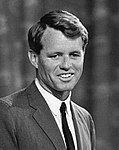Robert F. Kennedy assassination conspiracy theories
The conspiracy theories relating to the assassination of Robert F. Kennedy, a United States senator from New York, relate to non-standard accounts of the assassination that took place shortly after midnight on June 5, 1968, in Los Angeles, California. Robert F. Kennedy was assassinated at the Ambassador Hotel, during celebrations following his successful campaign in the Californian primary elections while seeking the Democratic nomination for U.S. President; Kennedy died the following day at Good Samaritan Hospital. The convicted murderer was a 24-year-old Christian Palestinian immigrant named Sirhan Sirhan, who remains incarcerated in Richard J. Donovan Correctional Facility for the crime. However, as with his brother's death, Robert Kennedy's assassination and the circumstances surrounding it have spawned various conspiracy theories, particularly regarding the existence of a second gunman. Such theories have also centered on a woman wearing a polka-dot dress claiming responsibility for the crime, and the involvement of the Central Intelligence Agency. Many of these theories were examined during an investigation ordered by the United States Senate and were judged to be erroneous by the Federal Bureau of Investigation, which investigated on the Senate's behalf.
Excerpt from the Wikipedia article Robert F. Kennedy assassination conspiracy theories (License: CC BY-SA 3.0, Authors).Robert F. Kennedy assassination conspiracy theories
South Mariposa Avenue, Los Angeles Koreatown
Geographical coordinates (GPS) Address Nearby Places Show on map
Geographical coordinates (GPS)
| Latitude | Longitude |
|---|---|
| N 34.0597 ° | E -118.2971 ° |
Address
Robert F. Kennedy Community Schools
South Mariposa Avenue
90005 Los Angeles, Koreatown
California, United States
Open on Google Maps







